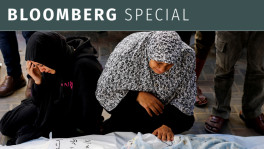Exit from lockdown
Our young population is the last resort for survival even though that means many of the older generation will also perish in the process

After the last four months of the raging pandemic around the world and here at home, one thing has become clear by now--covid-19 is here to stay for some time, at least until a vaccine is discovered, which may take up to a year at the earliest. Until then the world has to live with it just as it coexists with dengue or malaria.
And if that is how it turns out, what should be the exit plan for Bangladesh from the current shutdown/lockdown? Or rather, what future does it have to face once it decides to come out of the shutdown?
One thing is certain, just as the world at large, Bangladesh can ill afford an indefinite shutdown, nor will it make the virus disappear. So it should now prepare a plan to gradually open up the country and resume economic activities.
But compared to the rest of the world's experience of ending lockdowns, Bangladesh can hardly look forward to a painless transition to life as close to normal as possible.
When a lockdown is withdrawn partially or fully, a key and the first element should be maintaining physical distancing as the developed world is now practising.
This is what Belgium with the highest per capita death rate from covid-19 has planned. It will open a limited number of shops, fabric shops mostly. It will ask people to wear masks, it will start classes but with a slimmer number of students.
Spain, one of Europe's hardest-hit countries, is also opening its economy and has let building workers return to work.
Italy has opened its stationers and bookshops and Denmark is allowing children back into classrooms.
On the other side of the ocean, President Trump has the grandest plan to exit the lockdown which, however, has been called 'delusional' by some state governors.
But we have to be mindful of the huge differences between the realities of those countries and that of ours.
For Bangladesh, with a high population density, and the nature of economic activities, it is a difficult task to decide which businesses can open and which cannot, even if the parameter is crowd attention. Even a small vendor by the roadside serves more customers than is desirable at this time.
The world's rich countries can still maintain a lot of social distancing by working from home because their economies are highly service-focused.
In contrast, ours is a labour intensive one. Unless the hundreds of thousands of workers return to their crammed workplaces, the wheel of the economy will not turn.
Unless these workers get transported packed like sardines on buses from home to workplaces, they cannot make it there.
Social distancing, in its true sense, is an unenforceable concept here. And that alone is going to make a big impact on the coronavirus situation.
We may be looking at a massive number of people getting infected because the majority of our people are not infected yet.
Take Spain as an example, a country with high deaths and infections. Even if the official infection rate were 100 times higher, it will still have two-thirds of its population vulnerable. A lockdown withdrawal without proper measures will put them at risk of a second wave of attack.
It is almost certain Bangladesh will see the same development in infection rates and death rates. A second wave, a third wave.
Those who are not infected as yet will be exposed to the virus once the shutdown is withdrawn. The infection may actually shoot up at that moment because of increased social interaction. That will overwhelm the hospital system that is already strained beyond its limit and the result will be a greater health crisis.
At least this is how Bill Gates sees the future unfolding in less developed countries in his recent write-up titled "How to fight future pandemics" in The Economist.
"Their (less developed countries) experience, however, will be worse," he writes. "In poorer countries, where fewer jobs can be done remotely, distancing measures won't work as well. The virus will spread quickly, and health systems won't be able to care for the infected."
It brings us to the next element in the lockdown exit plan – the health system.
All the countries which are now planning to exit lockdowns have much better healthcare systems than ours. They have even bolstered their general health care systems so that even with an influx of patients the non-covid19 patients will not go untreated.
Sadly, Bangladesh does not have that luxury because of long neglect to its health care system through underfunding, bad planning and irregularities.
So we are hamstrung on this count again.
The third element in the exit policy is a massive ramping up of testing and contact-tracing. This can reveal where new infections are growing, who are spreading infections and then cut off the transmission line by tracing the spreaders.
Here again, Bangladesh has little chance of success. It could not as yet trace one single contact. We do not know who was the first spreader or who was the last.
A successful lockdown can help the developing countries handle the exit pain deftly. India is an example. With such a huge population, it could keep its cases down (despite the low number of testing) and deaths too. Now it can plan an exit on a positive note.
For Bangladesh, it also is a starter. The low infection rate and deaths (despite the low testing) can give it the courage to gradually come out of its lockdown.
But to make that transition, it would also require a massive investment in health workers to identify new infections and check that people are isolating themselves. One proposal says that America will need 260,000 recruits, up from just 2,200 today to accomplish such a goal.
Germany has engaged 200 public and private labs to increase tests. It now conducts 3.5 lakh tests a week. It now wants to track every infection contact and ramp up testing to 4.5 million a week. This will need employing thousands of health workers to collect swabs and do the testing.
For now, it is slowly opening up its economy because it knows its risks are measured.
The European Commission's roadmap for lifting lockdowns underpins the necessity to flatten the infection curve, a sufficiently robust health system and monitoring capacity.
Bangladesh's curve has not lifted much, mainly because of low testing. That could give it the nerve for an early start, but its anaemic health system and monitoring capacity will continue to plague its effort.
The importance of monitoring and testing can be understood from the Harvard University roadmap for the US that says massive testing is fundamental to reopening the US economy.
It starts with 5 million tests a day by early June that goes up to 20 million a day by late July.
And it would not come cheap. Harvard estimates America will have to spend between 50 and 300 billion dollars for that, needing to employ thousands of workers.
So for most countries like Bangladesh, the only choice left seems to be the concept of herd immunity, which allows a majority of the population to grow resistance to the virus by becoming infected and then recovering.
Our young population is the last resort for survival even though that means many of the older generation will also perish in the process.
"No country can afford a prolonged period of lockdowns, and least of all a country like India," said Jayaprakash Muliyil, a prominent Indian epidemiologist.
"You may be able to reach a point of herd immunity without infection really catching up with the elderly. And when the herd immunity reaches a sufficient number the outbreak will stop, and the elderly are also safe."
So it is now recommended for India to let 60 percent of its youths go back to normal life, get immuned through exposure to the virus and revive the economy. The only problem here is covid-19 can reinfect a person. There is no guarantee that once you get infected, you will not be reinfected.
Testing is a basic reliable tool to assess the real impact of the pandemic and to decide on the duration of the lockdown. But we are still lagging behind in this capability. We cannot ramp up our testing capacity even if it were a necessity. The per day testing still remains confined to more or less 3,000. This is hardly adequate. But there is no other choice left too because we do not have the testing facilities, the polymerase chain reaction or PCR machines needed to turn the RNA of covid-19 into DNA to determine the virus. Or the reagents. Or the swab collection team.
But in view of Professor Ridwanur Rahman, the head of the Research Centre at Universal Medical College, if we want to withdraw our lockdown, we have to increase our testing capacity to more than 20,000 a day.
He says with more than 20,000 tests done daily, anyone anywhere in the country with coronavirus symptoms will undergo the test.
If the result is positive, they will be isolated immediately. This is the way the spread of the disease can be contained, notes the professor.
When we achieve the capacity to identify each infected person and stop the spread of the disease through isolating patients, then the shutdown can be withdrawn, he adds.
But the reality does not allow us to be so hopeful.
In the last two months, we have been able to conduct around 43,000 tests. We have around 55,000 testing kits in stock which will be exhausted in two weeks.
Conducting massive tests and contact tracing require huge manpower and money.
The USA spends more than 17 percent of its GDP for its healthcare while European countries spend around 10 percent of their GDP.
Our healthcare system has remained neglected for decades. We spend less than one percent of the GDP for the healthcare sector. Our healthcare is one of the weakest in the world though we are one of the fastest growing economies in the globe.
In a tragic case of irony, the health crisis has now shuttered the entire economy putting the burden on the long neglected health care system to fight the lethal virus and the heavy duty to clear the way for relaxing the lockdown to reopen economic activities.


 Keep updated, follow The Business Standard's Google news channel
Keep updated, follow The Business Standard's Google news channel
















